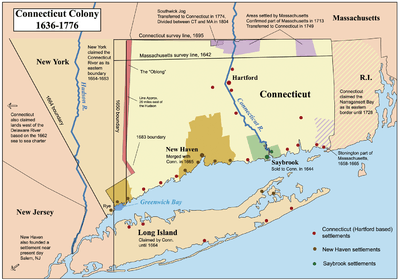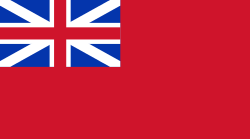Connecticut Colony
| Colony of Connecticut | ||||||||||||
| Colony of England (1636–1707) Colony of Great Britain (1707–76) | ||||||||||||
| ||||||||||||
 A map of the Connecticut, New Haven, and Saybrook colonies | ||||||||||||
| Capital | Hartford (1636–1776) New Haven (joint capital with Hartford, 1701–76) | |||||||||||
| Languages | English, Mohegan-Pequot, Quiripi | |||||||||||
| Government | Constitutional monarchy | |||||||||||
| Legislature | General Court of the Colony of Connecticut | |||||||||||
| History | ||||||||||||
| • | Established | 1636 | ||||||||||
| • | Independence | 1776 | ||||||||||
| Currency | Pound sterling | |||||||||||
| ||||||||||||
| Today part of | | |||||||||||
The Connecticut Colony or Colony of Connecticut, originally known as the River Colony, was an English colony located in North America that became the U.S. state of Connecticut. It was organized on March 3, 1636 as a settlement for a Puritan congregation. After early struggles with the Dutch, the English permanently gained control of the region in 1637. The colony was later the scene of a bloody war between the English and Pequot Indians known as the Pequot War. Connecticut Colony played a significant role in the establishment of self-government in the New World with its refusal to surrender local authority to the Dominion of New England, an event known as the Charter Oak incident which occurred at Jeremy Adams' inn and tavern.
Two other English settlements in the present-day state of Connecticut were merged into the Colony of Connecticut: Saybrook Colony in 1644 and New Haven Colony in 1662.
Leaders
Governor John Haynes of the Massachusetts Bay Colony led 100 people to present-day Hartford in 1636. He and Thomas Hooker, a prominent Puritan minister, are often considered the founders of the Connecticut colony. Hooker delivered a sermon to his congregation on May 31, 1638, on the principles of government, and it influenced those who wrote the Fundamental Orders of Connecticut later that year. The Fundamental Orders may have been drafted by Roger Ludlow of Windsor, the only trained lawyer living in Connecticut in the 1630s; they were transcribed into the official record by secretary Thomas Welles.
The Rev. John Davenport and merchant Theophilus Eaton led the founders of the New Haven Colony, which was absorbed into Connecticut Colony in the 1660s.
In the colony's early years, the governor could not serve consecutive terms. Thus, for twenty years, the governorship often rotated between John Haynes and Edward Hopkins, both of whom were from Hartford. George Wyllys, Thomas Welles, and John Webster, also Hartford men, sat in the governor's chair for brief periods in the 1640s and 1650s.
John Winthrop the Younger of New London, the son of the founder of the Massachusetts Bay Colony, played an important role in consolidating separate settlements into a single colony on the Connecticut River, and he served as Governor of Connecticut from 1659 to 1675. Winthrop was also instrumental in obtaining the colony's 1662 charter, which incorporated New Haven into Connecticut. His son Fitz-John Winthrop also governed the colony for ten years, starting in 1698.
Major John Mason was the military leader of the early colony, the commander in the Pequot War, a magistrate, founder of Windsor, Saybrook, and Norwich, and Deputy Governor under Winthrop.
Roger Ludlow was an Oxford-educated lawyer and former Deputy Governor of the Massachusetts Bay Colony who petitioned the General Court for rights to settle the area. Ludlow led the March Commission in settling disputes over land rights. He is credited as drafting the Fundamental Orders of Connecticut (1650) in collaboration with Hooker, Winthrop, and others. Ludlow was the first Deputy Governor of Connecticut.
William Leete of Guilford served as governor of New Haven Colony before the colony's merger into Connecticut, and as governor of Connecticut following John Winthrop, Jr's death in 1675. He is the only man to serve as governor of both New Haven and Connecticut.
Robert Treat of Milford served as governor of the colony, both prior to and after its inclusion in Sir Edmund Andros's Dominion of New England. His father Richard Treat was one of the original patentees of the colony.
Religion
The original colonies along the Connecticut River and in New Haven were established by separatist Puritans who were connected with the Massachusetts and Plymouth colonies. They held Calvinist religious beliefs similar to the English Puritans, but they maintained that their congregations needed to be separated from the English state church. They had emigrated to New England during the Great Migration.
Economic and social history
The economy began with subsistence farming in the 17th century, and developed with greater diversity and an increased focus on production for distant markets, especially the British colonies in the Caribbean. The American Revolution cut off imports from Britain, and stimulated a manufacturing sector that made heavy use of the entrepreneurship and mechanical skills of the people. In the second half of the 18th century, difficulties arose from the shortage of good farmland, periodic money problems, and downward price pressures in the export market. In agriculture there was a shift from grain to animal products.[1] The colonial government from time to time attempted to promote various commodities such as hemp, potash, and lumber as export items to bolster its economy and improve its balance of trade with Great Britain.[2]
Connecticut's domestic architecture included a wide variety of house forms. They generally reflected the dominant English heritage and architectural tradition.[3]
See also
- History of the Connecticut Constitution
- Connecticut Western Reserve
- History of Springfield, Massachusetts
Further reading
- Andrews, Charles M. The Colonial Period of American History: The Settlements, volume 2 (1936) pp 67–194, by leading scholar
- Atwater, Edward Elias (1881). History of the Colony of New Haven to Its Absorption into Connecticut. author. to 1664
- Burpee, Charles W. The story of Connecticut (4 vol 1939); detailed narrative in vol 1-2
- Clark, George Larkin. A History of Connecticut: Its People and Institutions (1914) 608 pp; based on solid scholarship online
- Federal Writers' Project. Connecticut: A Guide to its Roads, Lore, and People (1940) famous WPA guide to history and to all the towns online
- Fraser, Bruce. Land of Steady Habits: A Brief History of Connecticut (1988), 80 pp, from state historical society
- Hollister, Gideon Hiram (1855). The History of Connecticut: From the First Settlement of the Colony to the Adoption of the Present Constitution. Durrie and Peck., vol. 1 to 1740s
- Jones, Mary Jeanne Anderson. Congregational Commonwealth: Connecticut, 1636–1662 (1968)
- Roth, David M. and Freeman Meyer. From Revolution to Constitution: Connecticut, 1763–1818 (Series in Connecticut history) (1975) 111pp
- Sanford, Elias Benjamin (1887). A history of Connecticut.; very old textbook; strongest on military history, and schools
- Taylor, Robert Joseph. Colonial Connecticut: A History (1979); standard scholarly history
- Trumbull, Benjamin (1818). Complete History of Connecticut, Civil and Ecclesiastical. very old history; to 1764
- Van Dusen, Albert E. Connecticut A Fully Illustrated History of the State from the Seventeenth Century to the Present (1961) 470pp the standard survey to 1960, by a leading scholar
- Van Dusen, Albert E. Puritans against the wilderness: Connecticut history to 1763 (Series in Connecticut history) 150pp (1975)
- Zeichner, Oscar. Connecticut's Years of Controversy, 1750–1776 (1949)
Specialized studies
- Buell, Richard, Jr. Dear Liberty: Connecticut's Mobilization for the Revolutionary War (1980), major scholarly study
- Bushman, Richard L. (1970). From Puritan to Yankee: Character and the Social Order in Connecticut, 1690–1765. Harvard University Press.
- Collier, Christopher. Roger Sherman's Connecticut: Yankee Politics and the American Revolution (1971)
- Daniels, Bruce Colin. The Connecticut town: Growth and development, 1635–1790 (Wesleyan University Press, 1979)
- Daniels, Bruce C. "Democracy and Oligarchy in Connecticut Towns-General Assembly Officeholding, 1701-1790" Social Science Quarterly (1975) 56#3 pp: 460-475.
- Fennelly, Catherine. Connecticut women in the Revolutionary era (Connecticut bicentennial series) (1975) 60pp
- Grant, Charles S. Democracy in the Connecticut Frontier Town of Kent (1970)
- Hooker, Roland Mather. The Colonial Trade of Connecticut (1936) online; 44pp
- Lambert, Edward Rodolphus (1838). History of the Colony of New Haven: Before and After the Union with Connecticut. Containing a Particular Description of the Towns which Composed that Government, Viz., New Haven, Milford, Guilford, Branford, Stamford, & Southold, L. I., with a Notice of the Towns which Have Been Set Off from "the Original Six.". Hitchcock & Stafford.
- Main, Jackson Turner. Connecticut Society in the Era of the American Revolution (pamphlet in the Connecticut bicentennial series) (1977)
- Pierson, George Wilson. History of Yale College (vol 1, 1952) scholarly history
- Selesky Harold E. War and Society in Colonial Connecticut (1990) 278 pp.
- Taylor, John M. The Witchcraft Delusion in Colonial Connecticut, 1647–1697 (1969) online
- Trumbull, James Hammond (1886). The memorial history of Hartford County, Connecticut, 1633–1884. E. L. Osgood., 700pp
Historiography
- Daniels, Bruce C. "Antiquarians and Professionals: The Historians of Colonial Connecticut," Connecticut History (1982), 23#1, pp 81–97.
- Meyer, Freeman W. "The Evolution of the Interpretation of Economic Life in Colonial Connecticut," Connecticut History (1985) 26#1 pp 33–43.
References
Bibliography
- Berkin, Carol (1996). First Generations: Women in Colonial America. New York, NY: Hill and Wang. ISBN 978-0-8090-1606-8.
- Bushman, Richard L. (1993). The Refinement of America: Persons, Houses, Cities. New York, NY: Harvard University Press. ISBN 978-0-679-74414-6.
- Butler, Jon (1990). Awash in a Sea of Faith: Christianizing the American People. London: Harvard University Press. ISBN 978-0-67405-601-5.
- Daniels, Bruce C. (1980). "Economic development in colonial and revolutionary Connecticut: an overview". William and Mary Quarterly. 37 (3): 429–450. JSTOR 1923811.
- Green, Jack P.; Pole, J. R. (1984). Colonial British America: Essays in the New History of the Early Modern Era. Baltimore, MD: The Johns Hopkins University Press. ISBN 9780801830556.
- Hull, Brooks B.; Moran, Gerald F. (1999). "The churching of colonial Connecticut: a case study". Review of Religious Research. 41 (2): 165–183. JSTOR 3512105.
- Lipman, Andrew (2008). ""A meanes to knitt them togeather": the exchange of body parts in the Pequot War". William and Mary Quarterly. third series. 65 (1): 3–28. JSTOR 25096768.
- Nutting, P. Bradley (2000). "Colonial Connecticut's search for a staple: a mercantile paradox". New England Journal of History. 57 (1): 58–69.
- Smith, Ann Y. (2007). "A new look at the early domestic architecture of Connecticut". Connecticut History. 46 (1): 16–44.
- Williams, Peter W., ed. (1999). Perspectives on American Religion and Culture. Malden, MA: Blackwell Publishers. ISBN 978-1-5771-8117-0.
External links
| Wikimedia Commons has media related to Colony of Connecticut. |
Archival collections
- Guide to the Connecticut Colony Land Deeds. Special Collections and Archives, The UC Irvine Libraries, Irvine, California.
Other
- Colonial Connecticut Records: The Public Records of the Colony of Connecticut, 1636–1776
- Colonial Connecticut Town Nomenclature
- Connecticut Constitutionalism, 1639–1789
- Timeline of Colonial Connecticut History
Coordinates: 41°43′05″N 72°45′05″W / 41.71803°N 72.75146°W
